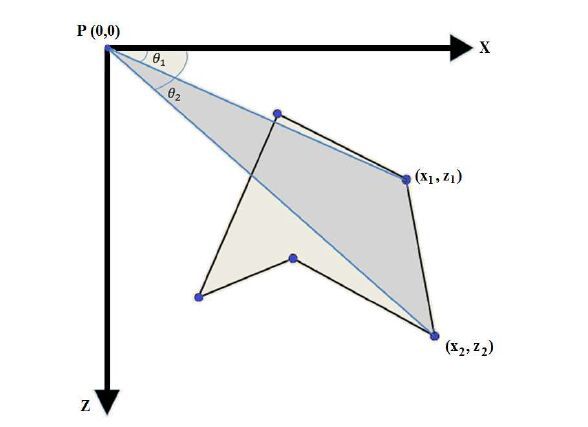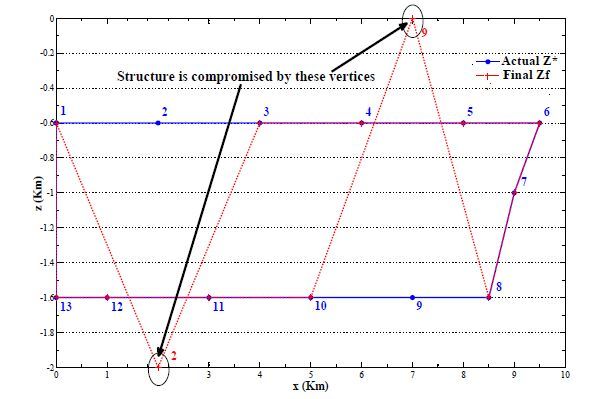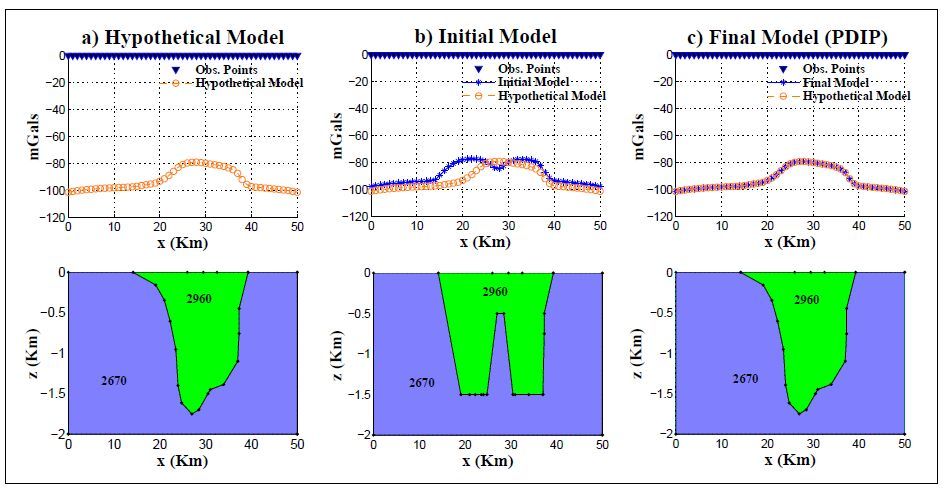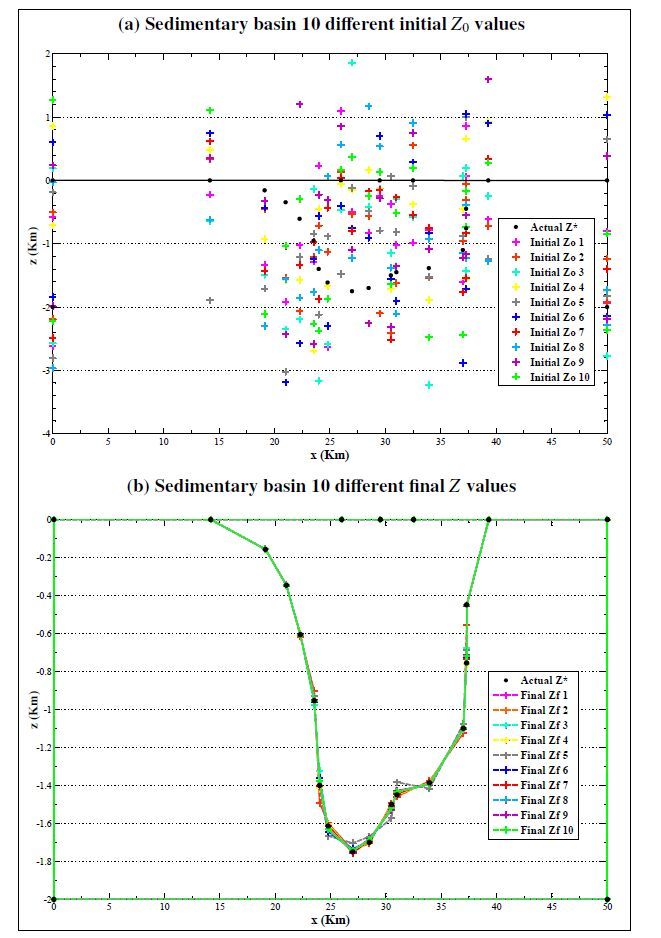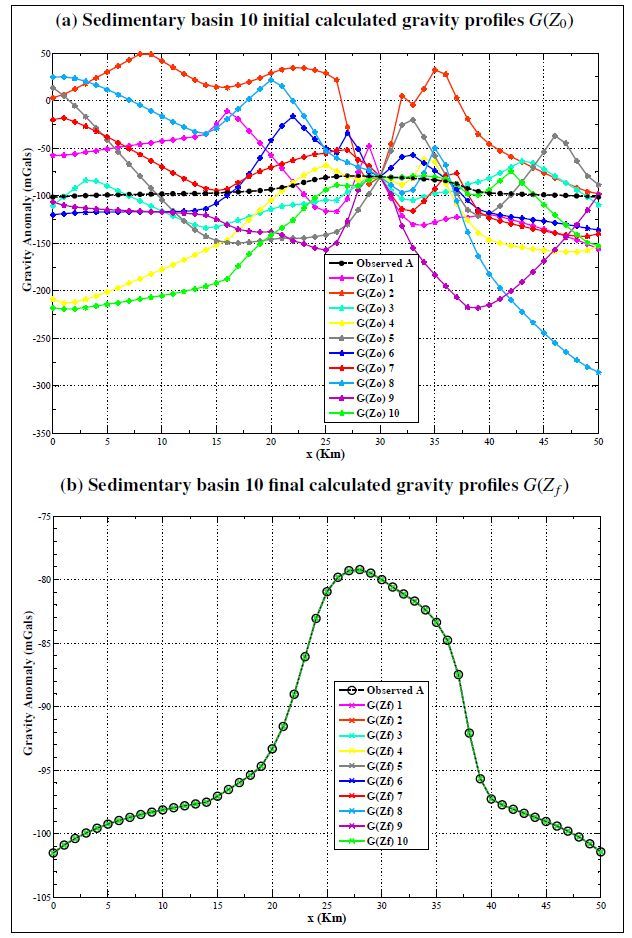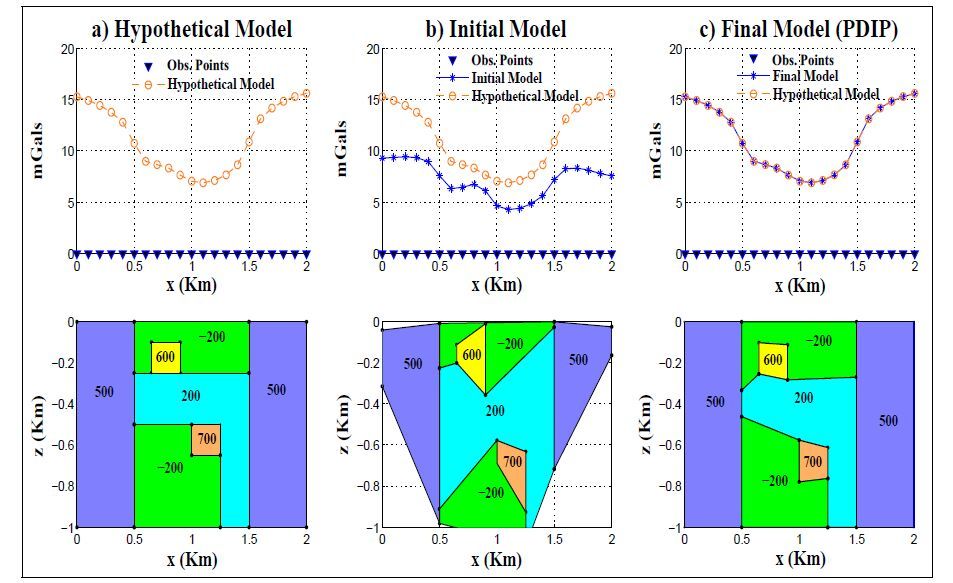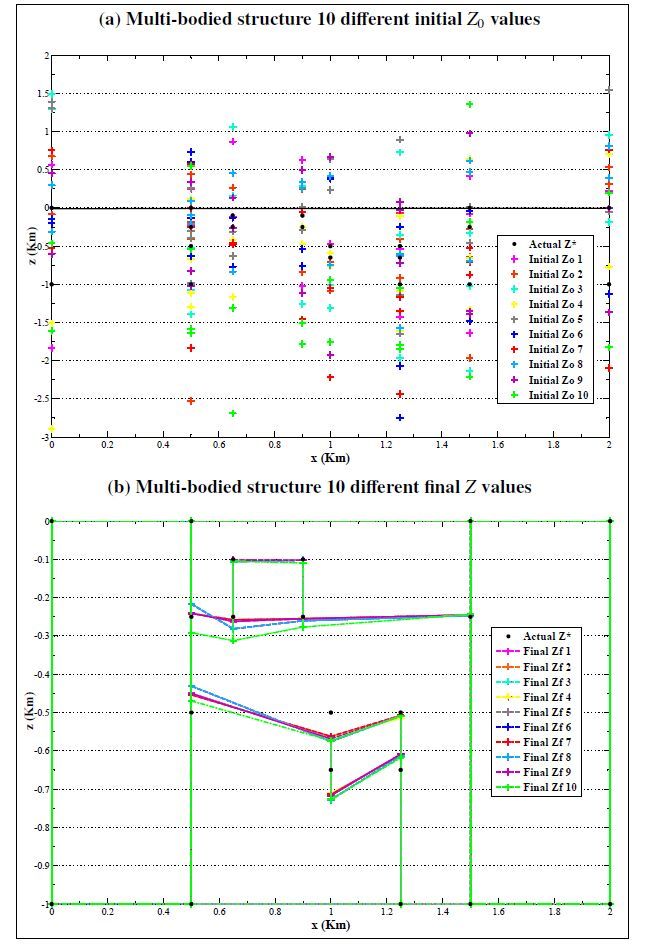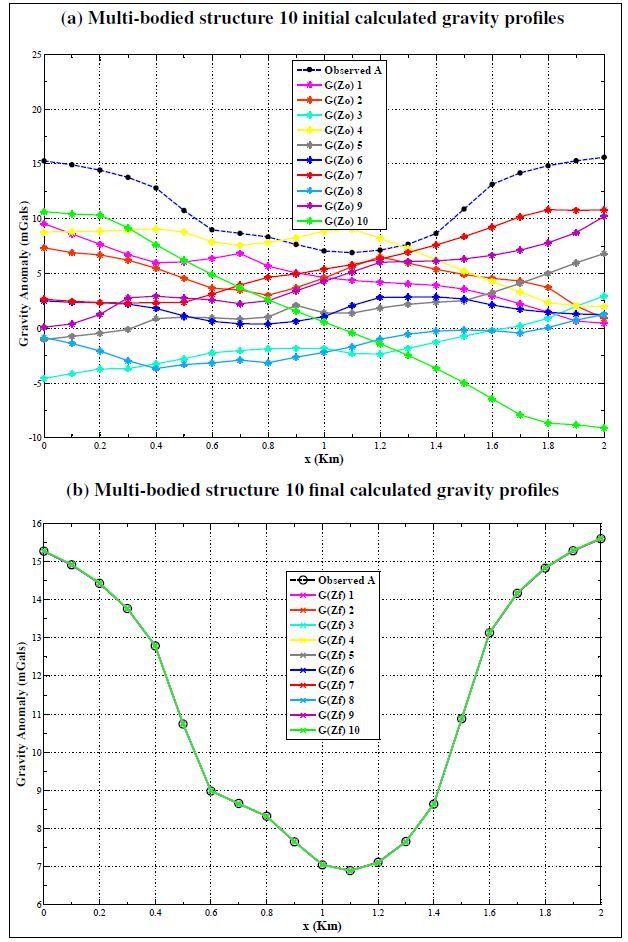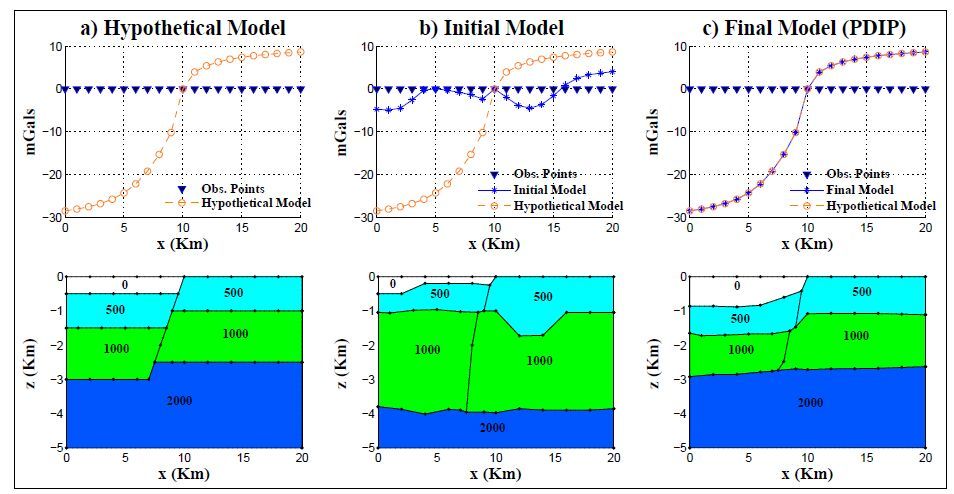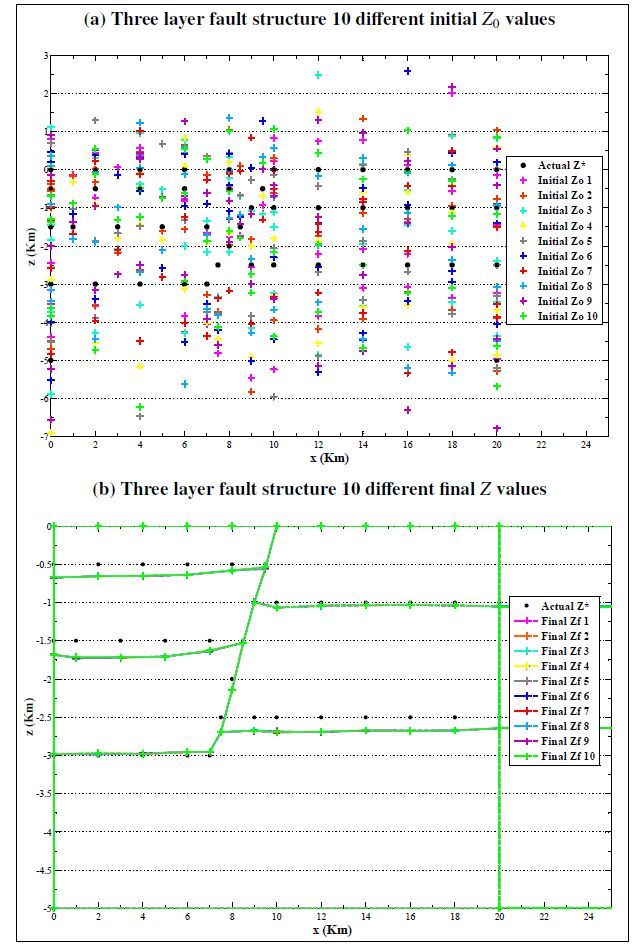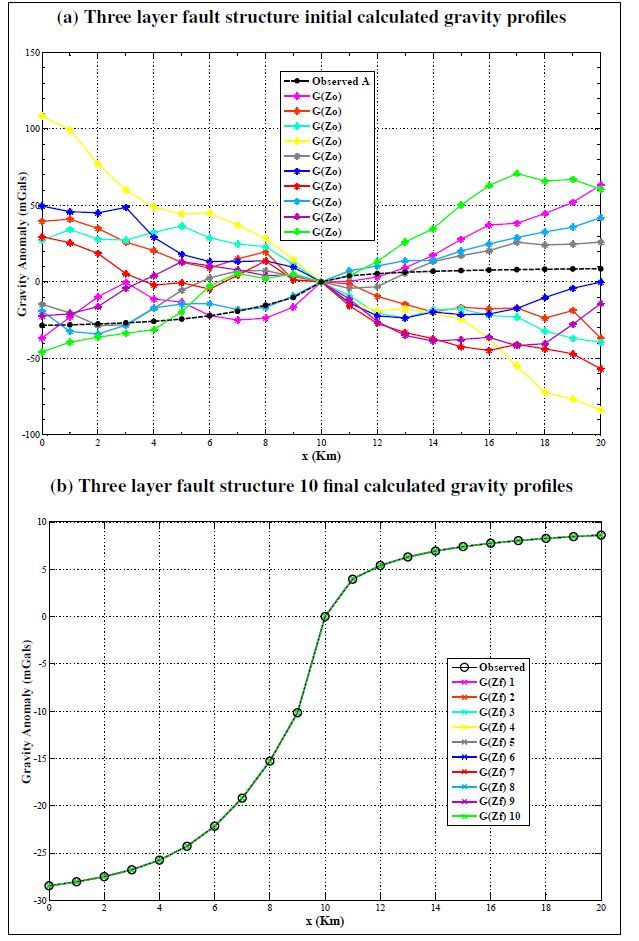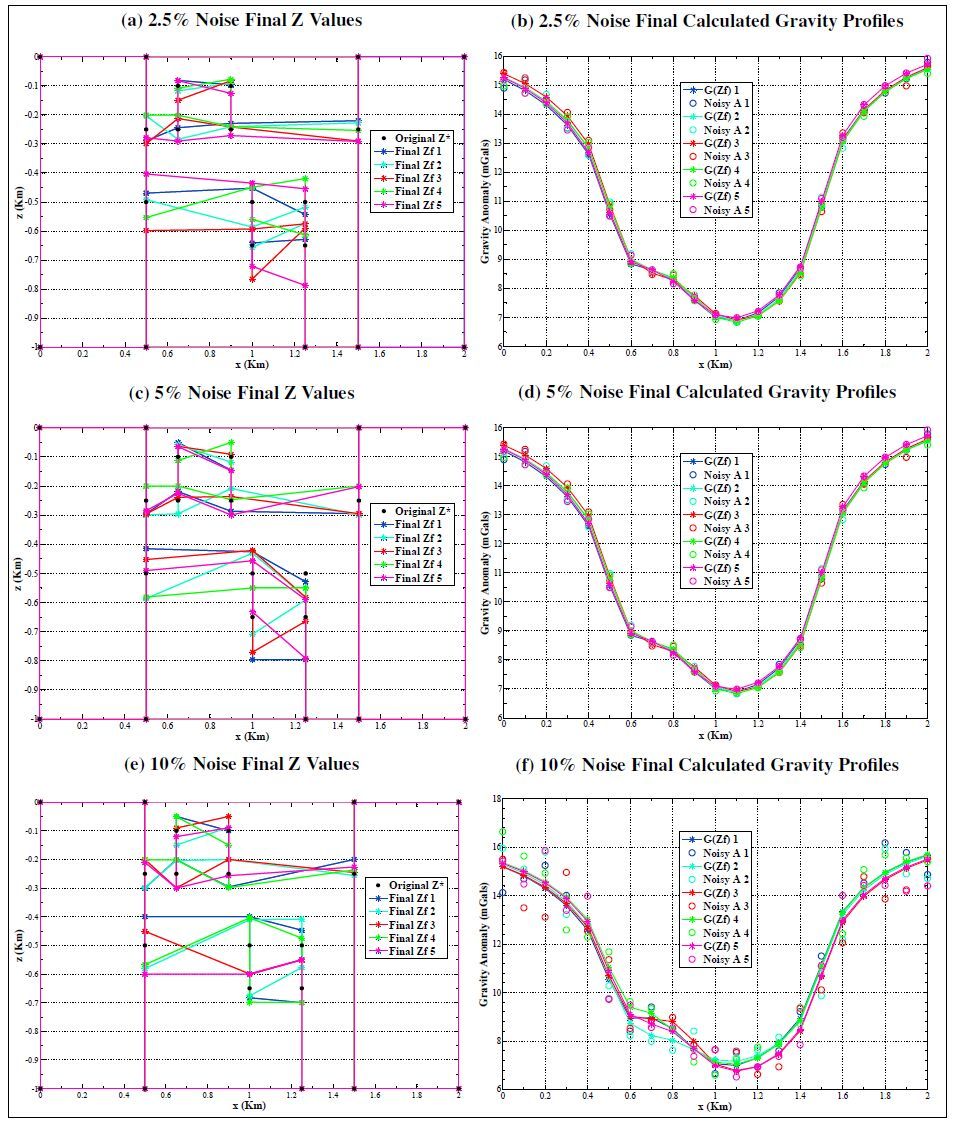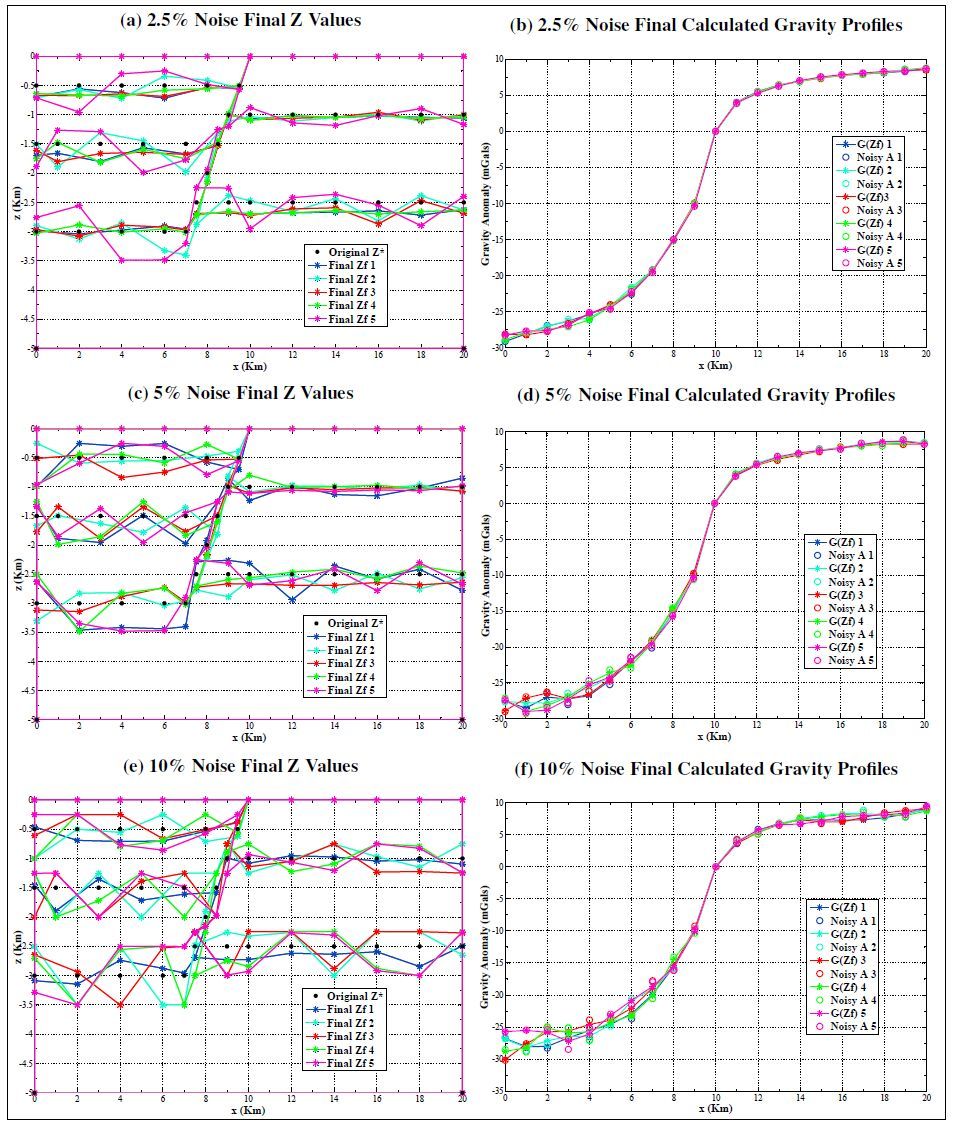Structural inversion of gravity datasets based on the use of density anomalies to derive robust images of the subsurface (delineating lithologies and their boundaries) constitutes a fundamental non-invasive tool for geological exploration. The use of experimental techniques in geophysics to estimate and interpret di erences in the substructure based on its density properties have proven e cient; however, the inherent non-uniqueness associated with most geophysical datasets make this the ideal scenario for the use of recently developed robust constrained optimization techniques. We present a constrained optimization approach for a least squares inversion problem aimed to characterize 2-Dimensional Earth density structure models based on Bouguer gravity anomalies. The proposed formulation is solved with a Primal-Dual Interior-Point method including equality and inequality physical and structural constraints. We validate our results using synthetic density crustal structure models with varying complexity and illustrate the behavior of the algorithm using di erent initial density structure models and increasing noise levels in the observations. Based on these implementations, we conclude that the algorithm using Primal-Dual Interior-Point methods is robust, and its results always honor the geophysical constraints. Some of the advantages of using this approach for structural inversion of gravity data are the incorporation of a priori information related to the model parameters (coming from actual physical properties of the subsurface) and the reduction of the solution space contingent on these boundary conditions.
1.
Introduction
The COVID-19 pandemic has spread globally since 2019, and it has been threatening the public health, economy and social life of all human beings, which is regarded as an unprecedented public crisis and challenge. As of 26 August 2021, over 213, 752, 662 infected cases have been reported with 4, 459, 381 deaths [1]. Non-pharmaceutical interventions (NPIs), such as personal protective measures (social distancing, hand washing, mask wearing, etc.), environmental measures (disinfecting and sterilizing), surveillance measures (large-scale screening, contact tracing, home quarantine, isolation, etc.), domestic and international travel restrictions, have been strictly implemented worldwide, and a mass vaccination program against COVID-19 has been actively promoted, to suppress SARS-CoV-2 transmission and reduce the mortality and morbidity of COVID-19. However, the situation remains severe and uncertain, in particular with the emerging of novel SARS-CoV-2 variants which may be more transmissible than the ancestral lineage first identified [2].
In China, the epidemic situation was almost under control with the strict NPIs and mass vaccination. However, imported cases from abroad, especially from high-risk regions, have occasionally caused several epidemic outbreaks in some cities [3,4,5,6]. For example, on 21 May 2021, a local confirmed case of COVID-19 from Liwan District, Guangzhou City, Guangdong Province was reported, causing a new round of infections, invoking concern [7]. The mutant strain (Delta variant, B.1.617.2) of the SARS-CoV-2 discovered in India spread into China for the first time during this outbreak [2,8], and it is 97% more transmissible than the original strain [9]. The higher transmissibility and shorter incubation period of the Delta variant [2,8,10,11,12] has introduced new challenges to the control of the outbreak.
Because of the experience of containing the COVID-19 outbreaks, the Guangzhou New Coronavirus Pneumonia Epidemic Prevention and Control Headquarters responded quickly to stop COVID-19 spread and protect the health and safety of the public [13]. Close contact tracing was immediately carried out, the traced contacts were quarantined centrally in dedicated accommodation such as hotels or quarantine centers, nucleic acid testing were performed during their quarantine period, and access to the regions where the infected cases had visited was restricted [14]. Simultaneously, multiple rounds of nucleic acid testing were performed in the closed management areas. Furthermore, the prevention and control of the epidemic were strengthened and the nucleic acid testing and screening of personnel were extended for all residents and temporary residents in the whole city. Several areas, including Baihedong Street, Zhongnan Street, Hailong Street, Dongjiao Street, Chongkou Street in Liwan District, Ruibao Street and Shayuan Street in Haizhu District, and Luopu Street in Panyu District were adjusted to closed management areas and were locked down successively from 29 May 2021, according to Announcement No. 13 of the Municipal Epidemic Prevention and Control Headquarters [15]. The compulsory home quarantine measure was implemented in closed management areas and people in these communities were required to stay at home. With the timely implementation of prevention and control measures and the active cooperation of the people in Guangzhou, the epidemic in Guangzhou was effectively curbed, and the closure and containment management measures were lifted successively. On 26 June, all medium risk areas in Guangzhou were cleared, and on the morning of 8 July, hospitalized cases were all recovered and cleared [16].
Quarantine measures including both the centralized quarantine by close contact tracing and the compulsory home quarantine measure, which is one of the most widely used NPIs [17,18] in the containment of COVID-19 in China, were implemented for the prevention and control of the epidemic in Guangzhou. However, despite the effectiveness of these two quarantine measures, the centralized quarantine measure is always very expensive since the traced close contacts would be isolated completely in dedicated accommodation such as hotels or quarantine centers and so is limited by resource restrictions, while though home quarantine may conserve resources, cross-infection and transmission within family households may occur [19,20,21], which may make the situation worse. Consequently, it is unclear how these two quarantine measures combine to contain COVID-19. Thus, in this study, by taking the epidemic in Guangzhou city in 2021 as an example, we aim to establish a stochastic discrete model to evaluate the effectiveness of the centralized quarantine and the home quarantine measures. Finding a balanced combination between them would be of considerable importance, providing policymakers with useful information for decisions of whether and when to implement the compulsory home quarantine measure.
The rest of this paper is organized as follows. The stochastic discrete model incorporating the two quarantine measures and cross-infection within family households is established and the data sets we used and parameter estimation methods are introduced in Section 2. The estimation results and sensitivity analysis of the impact of the quarantine rates and implementation timing of compulsory home quarantine are illustrated in Section 3. The discussion and conclusion are given in Sections 4 and 5.
2.
Methods
2.1. Model
Based on the transmission mechanism of COVID-19, the epidemiological status of individuals and the prevention and control measures implemented in Guangzhou city, we propose a discrete-time stochastic model [22,23,24] incorporating home quarantine, close contact tracing and centralized quarantine measures. The flow diagram of the transmission dynamics is presented in Figure 1. To clearly illustrate the model dynamic, we describe a deterministic version of the model in differential equations [25,26,27], given in model (1), followed by the discrete stochastic model (2) in the analysis.
The basic modelling framework for the transmission dynamics is an SEIHR model, in which the total population is divided into five classes: susceptible (S), exposed (E, people in this class are infected but not infectious), infectious (I, including both symptomatic and asymptomatic infectives), hospitalized (H), and recovered (R). The population is further divided into three categories according to their quarantine states: not quarantined, home quarantined and centralized quarantined. Here, we use the subscripts 'h' and 'q' to represent home quarantine and centralized quarantine, respectively. Denote N=S+E+I and Qh=Sh+Eh+Ih. The transmission occurs when the susceptible (or home quarantined susceptible) population in class S (or Sh) become close contacts of infectious (or home quarantined infectious) population in class I (or Ih) with the contact rate c1 (or c2) and then become infected with transmission probability β1 (or β2) per contact. Assume that a proportion q1 (or q2) of the close contacts for unquarantined (or home quarantined) individuals will be traced and move to the centralized quarantined susceptible/exposed compartments (Sq/Eq) if they are not infected/infected. The untraced population will stay in the susceptible (or home quarantined susceptible) class with proportion 1−q1 (or 1−q2) if they are not infected, or move to the exposed (or home quarantined exposed) class E (or Eh) if they are infected with the transmission probability β1 (or β2) per contact. Individuals in E or Eh class will enter into the infectious (I) or home quarantined infectious (Ih) class with the transition rate σ, where 1/σ is the incubation period. Note that population in compartment Eq are those who are carrying virus but would not transmit to others since people who are centralized quarantined have no contact with others, thus no infection or transmission occurs among them. While infection and transmission within family-households could not be ignored [28], and new infection may occur among home quarantined population, susceptible individuals in compartment Sh will be infected by infectious individuals in compartment Ih. Further, infected individuals in compartments I,Eq,Ih would be diagnosed and isolated at rates δI,δEq,δIh respectively, and individuals in I and H will be recovered at rate γI,γH, respectively. Susceptible individuals are released from Sq to Sh and from Sh to S with the releasing rates λ1,λ2, respectively. More detailed definition and values of variables and parameters are listed in Table 1.
Then we create a stochastic, time-discretized version of the model described above. Consider a time interval (t,t+Δt), where Δt represents the time between two discrete time points, here Δt=1 day. Because of the randomness of the disease infection and transmission, we assume that the flow between any two compartments is a stochastic process and the length of time that an individual spends in a compartment is exponentially distributed [23]. Let Dij(t) denote the number of individuals transferred out of compartment i, where i=1,2,…,9 represent the compartments S,E,I,Sq,Eq,Sh,Eh,Ih,H, respectively. The detailed descriptions of Dij(t) are given as follows:
• D11(t) is the number of newly infected individuals in unquarantined population;
• D12(t) is the number of newly centralized quarantined individuals who are close contacts but not infected in unquarantined population;
• D21(t) is the number of individuals transferred from exposed to infectious in unquarantined population;
• D31(t) is the number of newly reported cases diagnosed from unquarantined infectious population;
• D32(t) is the number of newly recovered individuals from unquarantined infectious individuals;
• D41(t) is the number of susceptible individuals released from centralized quarantine to home quarantine;
• D51(t) is the number of newly reported cases diagnosed from the centralized quarantined infected individuals;
• D61(t) is the number of newly infected individuals in home quarantined population;
• D62(t) is the number of newly centralized quarantined individuals who were close contacts but not infected in home quarantined population;
• D63(t) is the number of susceptible individuals released from home quarantine;
• D71(t) is the number of individuals transferred from exposed to infectious in home quarantined population;
• D81(t) is the number of newly reported cases diagnosed from home quarantined infectious individuals;
• D91(t) is the number of newly recovered cases from hospitalized individuals.
We have to emphasize that the compulsory home quarantine measure is implemented in closed management areas, here we assume it is implemented only once at the specific day with a fraction (pS,pE,pI) of individuals in unquarantined susceptible (S), exposed (E), infectious class (I) moving into the home quarantined susceptible (Sh), exposed (Eh), infectious class (Ih), respectively. Then the corresponding stochastic discrete-time model is specified by the following model:
with
Here, T is the corresponding time when the compulsory home quarantine strategy was implemented, and PS(t),PE(t),PI(t) are the proportions of unquarantined susceptible, exposed, infected individuals moved to the corresponding class home quarantined, respectively. Note that, for simplicity, we assume that the closed management areas were all announced on the morning of 29 May.
In model (2), Dij(t) are random variables with binomial distributions with probabilities Pij(t) :
where
2.2. Data collection and analysis
We collect the epidemic data of COVID-19 in Guangzhou city from the Guangzhou Municipal Health Commission [29] and the People's Government of Guangzhou Municipality [13]. The data include the number of newly reported confirmed cases, the number of newly reported asymptomatic cases (see dark blue and light blue bars in Figure 2). Furthermore, by tracing to the source, we notice that some of the newly reported cases (including both the confirmed and asymptomatic cases) diagnosed from centralized quarantined population, were the close contacts of a previously announced infected case. Thus, we obtain the daily number of newly quarantined exposed individuals (see green bars in Figure 2). And we also obtain the quarantine time and the admission time to calculate the average period of an infected individual being centralized quarantined.
To compare the two epidemics of Guangzhou in 2020 and 2021, we also collect the daily reported cases from 21 January 21 to 24 February 2020 in Guangzhou, as shown in Figure 2 (orange bars).
2.3. Model calibration and parameter settings
To calibrate the model, we use the epidemic data of COVID-19 from 21 May to 20 June 2021 in Guangzhou city to estimate the unknown parameters. Firstly, by reviewing literatures, we fix some parameter values and the initial values of the variables to be constants, as listed in Table 1. In particular, the periods for cases remaining in both the centralized quarantine and home quarantine are 14 days [25,26], thus λ1=λ2=114. The incubation period of the Delta variant is 4.4 days [8,31], thus σ=14.4. Furthermore, from the real data, we find that the duration for an infected individuals being centralized quarantined is 4.07 days, thus δEq=14.07. May 21 is set to be the initial time and S(0) is set as the number of residents in Guangzhou, which is about 15, 300, 000 [32]. Note that eight areas with about 470, 750 residents in total were assigned to be closed management areas, and the compulsory home quarantine strategy was implemented at the beginning of 29 May 2021 (i.e., the end of the 8th day) [15], thus T=8 and pS=0.0316. Since infected cases has not been reported at the beginning of 21 May, there were no home quarantined or centrally quarantined individuals, thus Sq(0)=0,Eq(0)=0,Sh(0)=0,Eh(0)=0,Ih(0)=0,H(0)=0,R(0)=0.
Then by using the least square method, we fit model (2) with the number of newly reported cases, the number of newly infected cases being traced and centralized quarantined, and the accumulative number of reported cases from 21 May to 20 June in Guangzhou, and consequently estimate the values of unknown parameters, as shown in Table 1.
2.4. Estimation of the effective reproduction number
We estimate the exponential growth rate of the daily reported cases and the effective reproduction number of the epidemic in Guangzhou in 2020 and 2021, respectively, to compare the two epidemics with different variants of SARS-CoV-2 in Guangzhou.
The basic reproduction number is calculated by using the formula R0=1∫∞a=0e−ra g(a)da, where r is the corresponding exponential growth rate and g(a) is the generation interval distribution. Here the generation interval distribution was assumed to follow a Gamma distribution with mean 3.95 days and standard deviation 1.51 days in 2020 [36], and with mean 2.9 days and standard deviation 1.9 days in 2021 [8].
To estimate the effective reproduction number, let Mt be the number of newly reported cases on day t, which is assumed to follow a Poisson distribution, and gτ be the discretized serial interval distribution which is assumed to follow a Gamma distribution with mean 3.95 days and standard deviation 4.24 days in 2020 [36], and with mean 2.3 days and standard deviation 3.4 days in 2021 [8]. Then with the renewal equation E(Mt)=Rt∑tτ=1gτMt−τ, where E(·) represents the expectation of a random variable, we can estimate the effective reproduction number Rt by applying a Bayesian method [34,35]. Assume that Rt is constant in the time interval [t−t1+1,t] for t≥t1, here we choose a time window with t1=5, and the prior distribution of Rt is a Gamma distribution with shape parameter a=1 and scale parameter b=5. Then the posterior distribution of Rt is a Gamma distribution with shape parameter and scale parameter being a+∑ts=t−t1+1Ms and (1b+∑ts=t−t1+1∑sτ=1gτMs−τ)−1, respectively. Then the estimated value of Rt is set to be the median of the posterior distribution and the 0.025 and 0.975 quantiles are used to calculate the 95% confidence intervals.
3.
Results
3.1. Estimated results
By fitting the stochastic discrete model (2) to the epidemic data in Guangzhou from 21 May to 20 June 2021, we obtain the estimated values of unknown parameters listed in Table 1. The fitting results are shown in Figure 3, revealing that the fitted model captures the data well, in which the black circles are the daily case data reported (Figure 3(a)), the traced data of newly quarantined cases (Figure 3(b)), the cumulative case data reported (Figure 3(c)), the pink curves are the simulation results with the estimated parameters each time and the red curves are the mean results with the estimated parameters for 200 simulations.
Then by using the next generation matrix performed on the corresponding continuous model (1), we get the basic reproduction number as
which is estimated as R0=2.8359, consistent with the result in [8].
The estimation results show that c1 is much greater than c2, while the values of β1 and β2 are only a little different, which means that the home quarantining contributes to reducing the contact rate greatly. q1 is much less than q2, meaning that the contact tracing and centralized quarantine rates for home quarantined individuals is much greater, and that the home quarantining increases the accuracy of the contact tracing. The proportion of infected individuals move into home quarantine (i.e., pE and pI) are close to 1, which means that the majority of infected cases (including exposed cases and infectious cases) are home quarantined, which is consistent with the fact that almost all reported cases were in the closed management areas [33].
3.2. Comparison of two epidemics in Guangzhou in 2020 and 2021
By estimating the exponential growth rate of the newly reported cases in the early stage of the epidemic, we obtain that the exponential growth rate is 0.4044 per day and the basic reproduction number is calculated as 4.2025 in the epidemic in Guangzhou 2020, and the exponential growth rate is 0.3508 per day and the basic reproduction number is calculated as 2.3259 in 2021, which is in the 95% CI in [8]. The exponential growth curves and the effective reproduction numbers in 2020 and 2021 are shown in Figure 4. The results show that the basic reproduction number of Guangzhou in 2021 is much lower than that in 2020, which is not consistent with the fact that the Delta variant is much more transmissible than the original strain, and the basic reproduction number is 2.1-2.85 times greater [12,37]. This is mainly attributable to the implementation of the normalized control interventions and the actively promoted vaccination program in 2021, which also indicates that the vaccine against COVID-19 is useful for protecting the city from a higher transmission risk. Thus, it is important to maintain the NPIs and promote the vaccination program.
3.3. Effectiveness evaluation
Based on the above estimated results, we focus on the effectiveness of the centralized quarantine and the home quarantine on the epidemic containment in Guangzhou in 2021. Therefore, through numerical analysis, we will analyze the impact of the timing T of the implementation of the compulsory home quarantine measure, the diagnosis rate δIh for home quarantined individuals, the centralized quarantine rate q1 for unquarantined individuals, the centralized quarantine rate q2 for home quarantined individuals, on the final size and the end time of the epidemic.
First of all, we conduct a sensitivity analysis to show what would happen if the compulsory home quarantine measure was implemented in advance or later, as shown in Figure 5 and Table 2. The results show that, if the compulsory home quarantine measure was implemented ahead of time, both the newly reported cases and the newly quarantined cases would be greatly decreased (Figure 5) and the end time of the epidemic would be significantly brought forward. The numbers of reported cases diagnosed from the unquarantined, the centralized quarantined and the home quarantined individuals all decrease. In particular, if T=5 or T=3, namely, the compulsory home quarantine measure was implemented 3 days or 5 days ahead of time (on 24 or 26 May), the number of reported cases from unquarantined, the centralized quarantined and the home quarantined individuals would be 6, 31, 23 or 3, 16, 12, respectively (see Table 2), being reduced by 57.14%, 63.1%, 58.93% or 78.57%, 80.95%, 78.57%, respectively. The final size would be reduced by 61.04% or 79.87% (reduced from 154 cases to 60 cases or to 31 cases), and the period of the epidemic would be shortened by 9 or 13 days (the end time would be brought forward from 18 to 10 or 5 June). Delaying the implementation timing of the compulsory home quarantine measure would lead to a more severe epidemic, with more reported cases and longer epidemic length. The numbers of reported cases diagnosed from the unquarantined, the centralized quarantined and the home quarantined individuals would all increase. In particular, if T=9 or T=11, namely, the compulsory home quarantine measure was implemented 1 day or 3 days later (on 30 May or 1 June), the number of reported cases from the unquarantined, the centralized quarantined and the home quarantined individuals would be 19, 117, 77 or 30, 191, 123, respectively (see Table 2), being increased by 35.71, 39.29, 37.5% or 114.29, 127.38, 119.64%, respectively. The final size would be increased by 38.31% or 123.38% (increased from 154 to 213 or to 344 cases), the epidemic would be lengthened by 3 or 8 days (the end time would be postponed from 18 to 21 or 26 June. In Table 2, the final size and the end time of the epidemic varying with respect to different implementation timings of the compulsory home quarantine measure are summarized.
The parameter δIh reflects the screening rate of the home quarantined individuals, and the quarantine rate q2 from home quarantine to centralized quarantine reflects the contact tracing accuracy of the home quarantined individuals. In order to further investigate the impact of δIh and q2 on the final size and the end time of the epidemic in Guangzhou, with different implementation timings T of the compulsory home quarantine measure, we illustrate the relationships with contour plots of the final size and the length of the epidemic with respect to T and δIh, T and q2, respectively (Figures 6 and 7). The results indicate that the final size and the length of the epidemic both decrease with the decreasing of T and increasing of δIh and q2, meaning that despite early implementation of the compulsory home quarantine measure, strengthening the screening and the contact tracing intervention of the home quarantined individuals can also help to control the epidemic. However, it follows from Figure 6 (a), (b) that if the value of δIh is small enough, for example, δIh=0.08, the final size would exceed 500 and the epidemic would last over 50 days, which are both far more than the actual situation with 154 cases and 29 days, regardless of the value of T. This means that the effectiveness of the early implementation of the compulsory home quarantine measure would be wasted if the home quarantine population were not sufficiently screened and tested. Another important point is that delaying the implementation timing leads to a severer epidemic than the actual situation even with stricter screening and testing intervention (larger δIh), for example, when T=10, the final size would be no less than 200 and the duration of the epidemic would be no shorter than 30 days, regardless of the value of δIh. Similar results can be obtained for q2 and T from Figure 7 (a) and (b). What is worse, if the quarantine rate q2 is decreased to the quarantine rate q1 (q2=q1=0.1719), the epidemic would last more than 100 days and the final size would be almost 500 cases, much severer than the actual situation. The results demonstrate the importance of enhancing the screening and the contact tracing interventions for individuals home quarantined, as well as the early implementation of the compulsory home quarantine policy.
To further investigate the combined effect of the centralized quarantine and home quarantine on the epidemic in Guangzhou in 2021, especially the impact of the quarantine rate q1 for unquarantined individuals, the quarantine rate q2 for home quarantined individuals, and the implementation timing T of the compulsory home quarantine measure, counter plots of the final size and the duration of the epidemic with respect to q1 and T, q1 and q2, are conducted respectively (Figures 8 and 9). It follows from Figure 8 that increasing q1 would greatly decrease the final size and significantly shorten the duration of the epidemic. Furthermore, with a quarantine rate q1 greater than 0.5, though increasing T would increase the final size and lengthen the duration of the epidemic, the epidemic can be eliminated in 25 days with less than 100 reported cases in total, regardless of the value of T. In particular, by fixing the implementation timing T=8, increasing q1 to the level of q2, which is the quarantine rate for those home quarantined, i.e., q1=q2=0.9277, the epidemic in Guangzhou would be eliminated in 2 weeks and the final size would be less than 30, illustrating the importance of enhancing the contact tracing intensity in the initial stage of the epidemic. Figure 9 shows that given the implementation timing T=8 of the compulsory home quarantine measure, if the quarantine rate q1 is large enough, for example, q1=0.8, then increasing the quarantine rate q2 would have a slight impact on controlling the epidemic. However, if q1 is not large enough, then increasing q2 to exceed a critical level would be useful to control the epidemic. Both contour plots illustrate the high efficiency of the contact tracing and centralized quarantine intervention in the early stages of the epidemic.
4.
Discussion
Several outbreaks of COVID-19 have occurred in China after the successful control of the outbreak in early 2020. One of the main reasons for the resurgence is imported cases from high-risk regions and the introduction of more transmissible variants. Since it is still impossible to develop a long-term effective vaccine against the new coronavirus, exploring an efficient and useful epidemic prevention model plays an important role in the healthy development of the entire human society. In China, despite the actively promoted vaccination program, there are three main strategies implemented by the government: the precise control strategy including the contact tracing and centralized quarantine, screening and testing of the close contacts; the key group-based control strategy, such as home quarantine; and the whole population-based control strategy, for example, large-scale nucleic acid screening and testing.
In this paper, we proposed a discrete stochastic model based on the transmission progression of the COVID-19 epidemic in Guangzhou from 21 May 2021 caused by the Delta variant, and the prevention and control policy, which described the combined strategies of centralized quarantine by close contact tracing and the compulsory home quarantine measures, to investigate the efficiency of the combined strategies. The proposed model was calibrated by using the data of the COVID-19 epidemic in 2021 in Guangzhou city from 21 May to 20 June (Figure 3). The estimation showed that the centralized quarantine rate for home quarantined individuals was much greater than that for unquarantined individuals, indicating that the home quarantine measure contributed to increasing the contact tracing accuracy.
It has been well known that the Delta variant of SARS-CoV-2 is 97% more transmissible than the original strain, and the basic reproduction number is 2.1-2.85 times greater [12,37]. However, the comparison of the epidemic in 2020 with the epidemic in 2021 in Guangzhou showed that the exponential growth rate of the number of newly infected cases in 2021 was smaller than that in 2020, and the basic reproduction number in 2021 was lower than that in 2020 (Figure 4), which indicated that the normalized control interventions and the vaccination program have played an important role in the control and prevention of the COVID-19 epidemic in 2021 in Guangzhou. Hence, it is vital to maintain the implementation of normalized control interventions and actively promote the vaccination program to avoid the transmission of the variants with high transmission ability.
We investigated how the final size and the duration of the epidemic change with respect to different parameters, including the implementation timing T of the compulsory home quarantine, the diagnosis rate δIh, the centralized quarantine rate q2 for home quarantined individuals, the centralized quarantine rate q1 for unquarantined individuals. Sensitivity analysis showed that the earlier that the compulsory home quarantine policy was issued, the quicker the epidemic would be eliminated and the lower the final size (Figure 5 and Table 2). The results showed that 94 infections would be avoided if the compulsory home quarantine measure was implemented 3 days earlier and 190 infections would be increased if the compulsory home quarantine measure was implemented 3 days later.
We observed from Figures 6 and 7 that bringing forward the implementation timing only was not enough, as enhancing the screening and testing intervention and increasing the accuracy of close contact tracing for individuals were also important. Even if the compulsory home quarantine measure was carried out on the first day, there would be a severer outbreak if the screening or contact tracing for home quarantined individuals was weakly implemented. Figures 8 and 9 told us that despite the timely implementation of the compulsory home quarantine measure, the strict centralized quarantine measure by close contact tracing for home quarantined population, the centralized quarantine measure in the initial stage of the epidemic (before the implementation of home quarantine measure) played an important role in curbing the epidemic transmission. The results showed that a sufficiently implemented contact tracing and centralized quarantine strategy for unquarantined population in the initial stage would contain the epidemic faster with less infections, even with weakly implemented compulsory home quarantine measure. However, if the contact tracing intensity was insufficient, then early implementation of the compulsory home quarantine measure and enhancing the screening of testing for home quarantined individuals indeed would prevent a large outbreak. The contact tracing intensity could be further enhanced if automatic tracing using an application on mobile telephones was introduced, as one has been shown to curb the spread of COVID-19 in the United Kingdom [38].
We have to point out that, several districts with a total population 470, 750 were adjusted to closed management areas successively from 29 May 2021 [15], the compulsory home quarantine measure was implemented gradually in these areas other than on the specific day, the population that were home quarantined varied per day, thus it may be more reasonable to incorporate time varying proportions of unquarantined susceptible, exposed, infected individuals becoming home quarantined susceptible, exposed, infected individuals, respectively. Further, we focused on the situation in Guangzhou and did not consider the cost of the centralized quarantine measure, the compulsory home quarantine measure. However, both of these two quarantine strategies require high expenditure, thus how to balance the expense, on the basis of the principle that the fewer the number of reported cases as possible, the better, would be interesting and important in countries with limited resources. These all fall in the scope of our further work.
5.
Conclusions
The epidemic in Guangzhou in 2021, together with several other recent outbreaks in Nanjing and Zhengzhou in China, revealed that the emerging variants with higher transmission ability are a major concern when designing measures to prevent the resurgence of COVID-19 in China. An overall control strategy combining the precise control strategy, the key group-based strategy and the whole population-based control strategy should be maintained even with a mass vaccination program. Furthermore, more attention should be paid to the precise control strategy once a positive case is reported, and the key group-based control measure should be strictly implemented if the initial precise control strategy is not put into effect with sufficient rigour.
Acknowledgments
The authors are supported by the National Natural Science Foundation of China (grant numbers: 12031010(ST), 12001349(WZ), 12126350(ST)) and the Postdoctoral Research Foundation of China (grant number: 2019M663611 (WZ)).
Conflict of interest
The authors declare there is no conflict of interest.










 DownLoad:
DownLoad:









